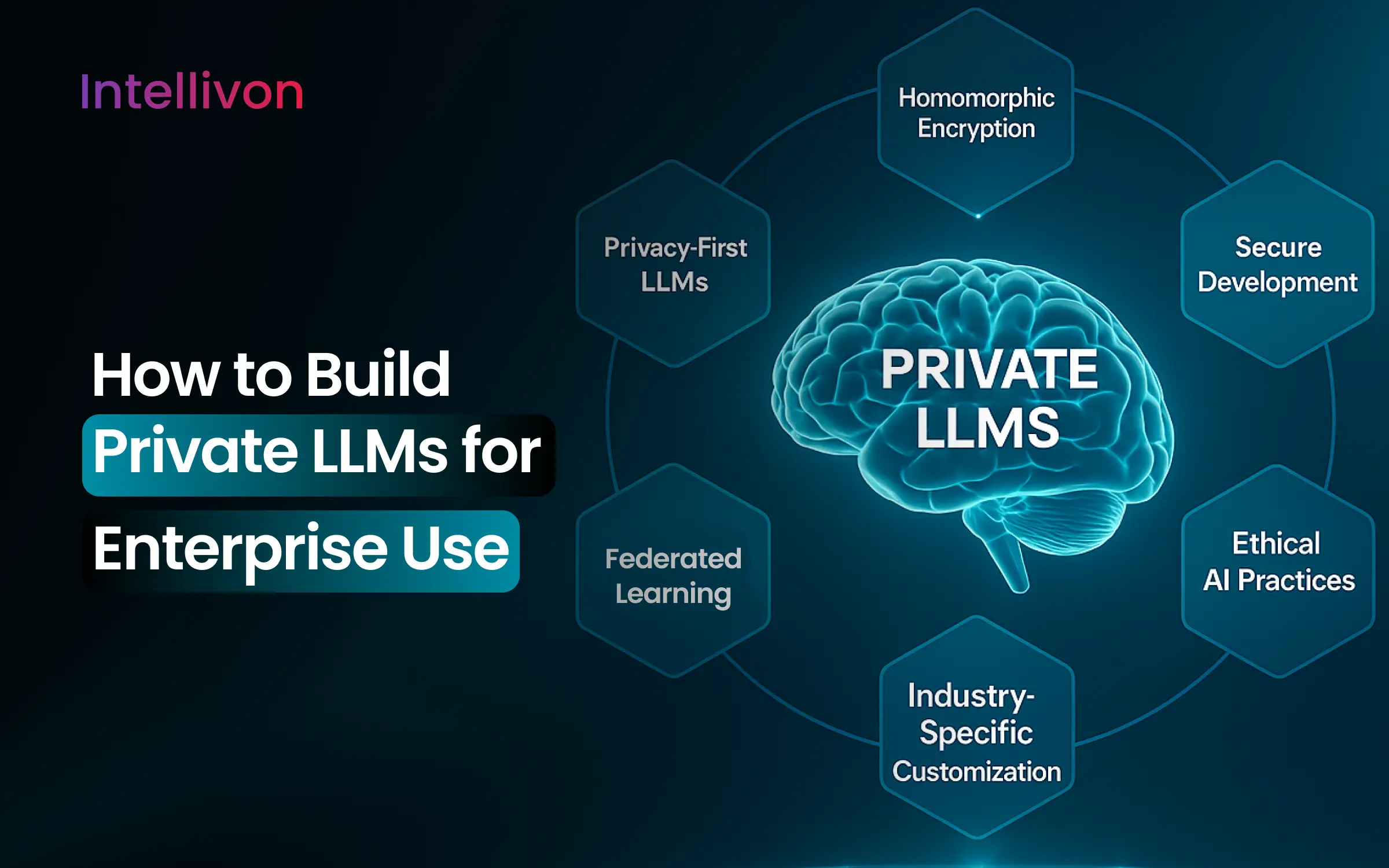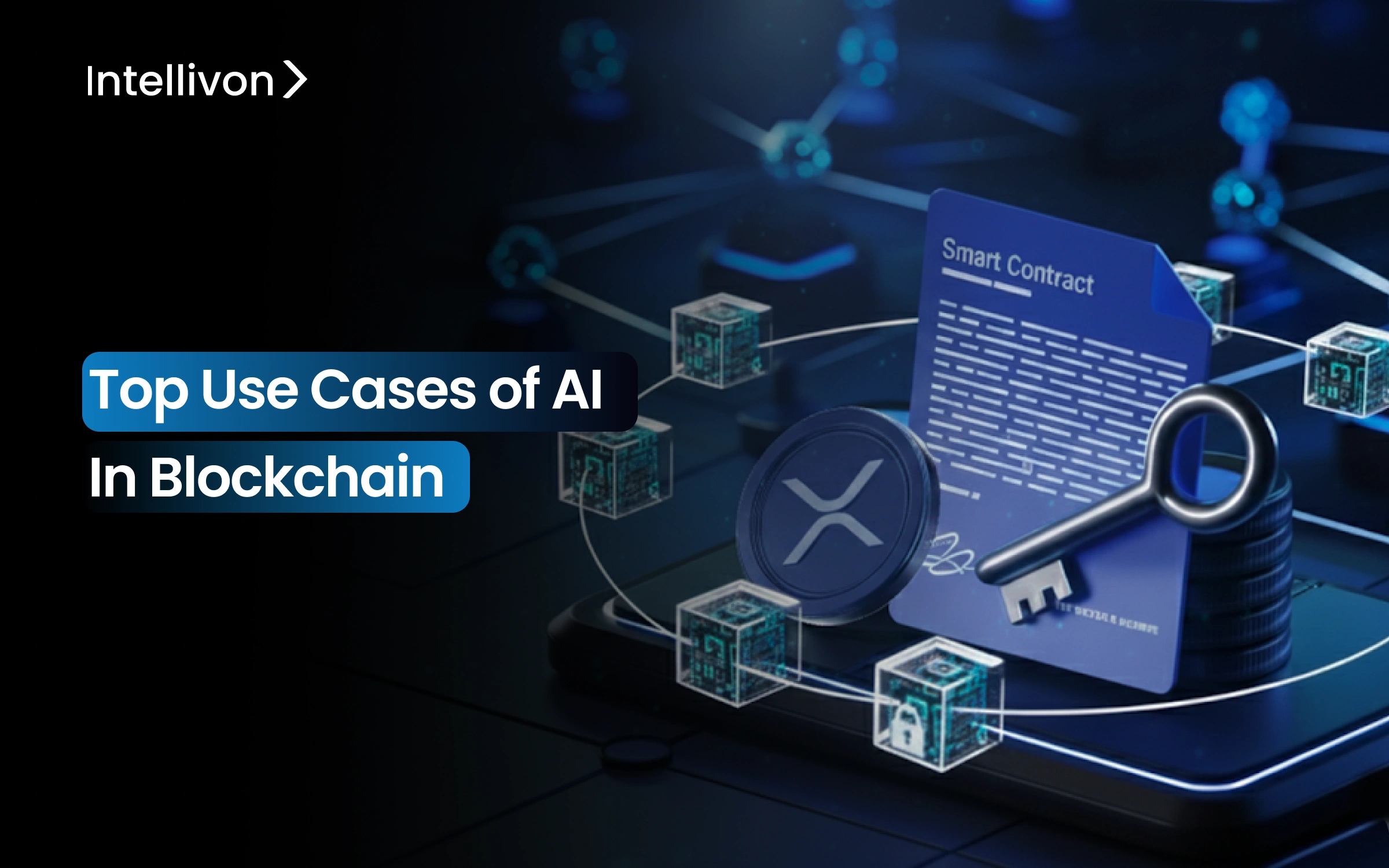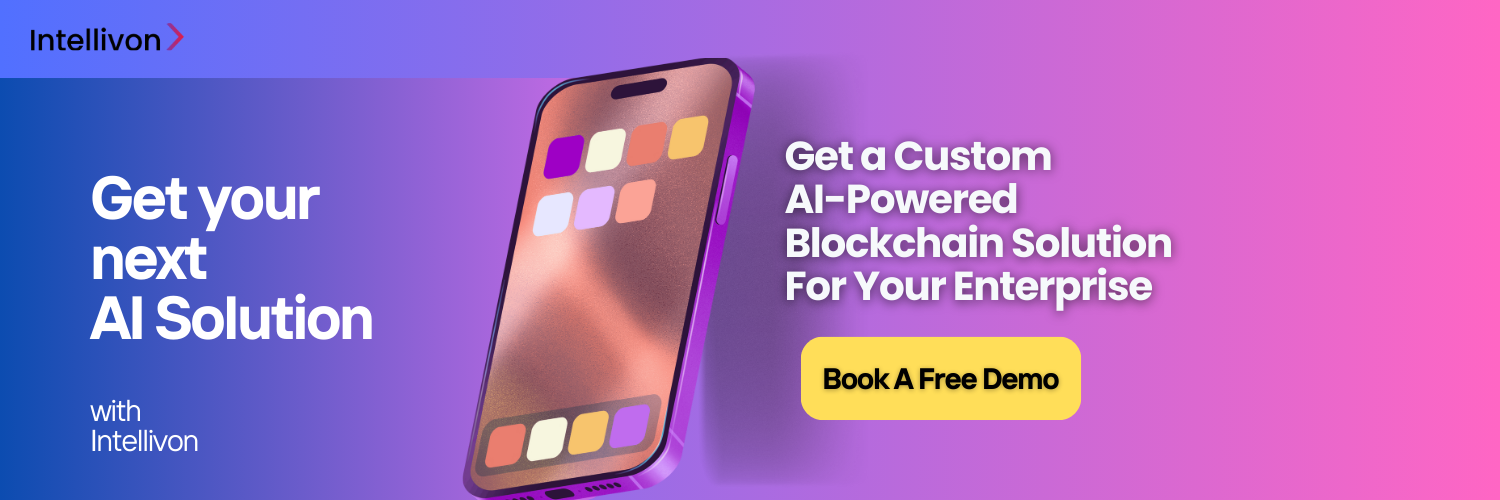The combination of AI and blockchain is changing how businesses handle security, automation, and trust. This powerful mix brings together artificial intelligence’s ability to predict with blockchain’s reliable transparency. The result is solutions that are more efficient and secure than what each technology could achieve on its own.
AI is great at processing data and spotting patterns, while blockchain offers the trust layer that today’s companies need. Together, they create a partnership where AI improves blockchain operations and boosts smart contracts, while blockchain maintains the integrity of AI-driven decisions. Across finance, supply chain, and data markets, companies like HSBC, Walmart, and Ocean Protocol are already using AI-blockchain solutions to automate compliance, boost transparency, and create entirely new business models.
Intellivon has years of experience in creating and deploying AI-powered blockchain solutions for large enterprises in specific use cases. In this guide, we will look at the main reasons for AI adoption in blockchain. We will see how AI increases the value of enterprise blockchain, highlight real-world applications in different sectors, and discuss the challenges of implementation. We will also show how Intellivon’s expertise can help companies take advantage of this transformative technology mix confidently.
Key Takeaways of the Adoption of AI in the Blockchain Market
The market for AI in Blockchain is expanding quickly. It was valued at USD 680.89 million in 2025 and is forecast to exceed USD 4.3 billion by 2034, growing at a CAGR of 22.93%.
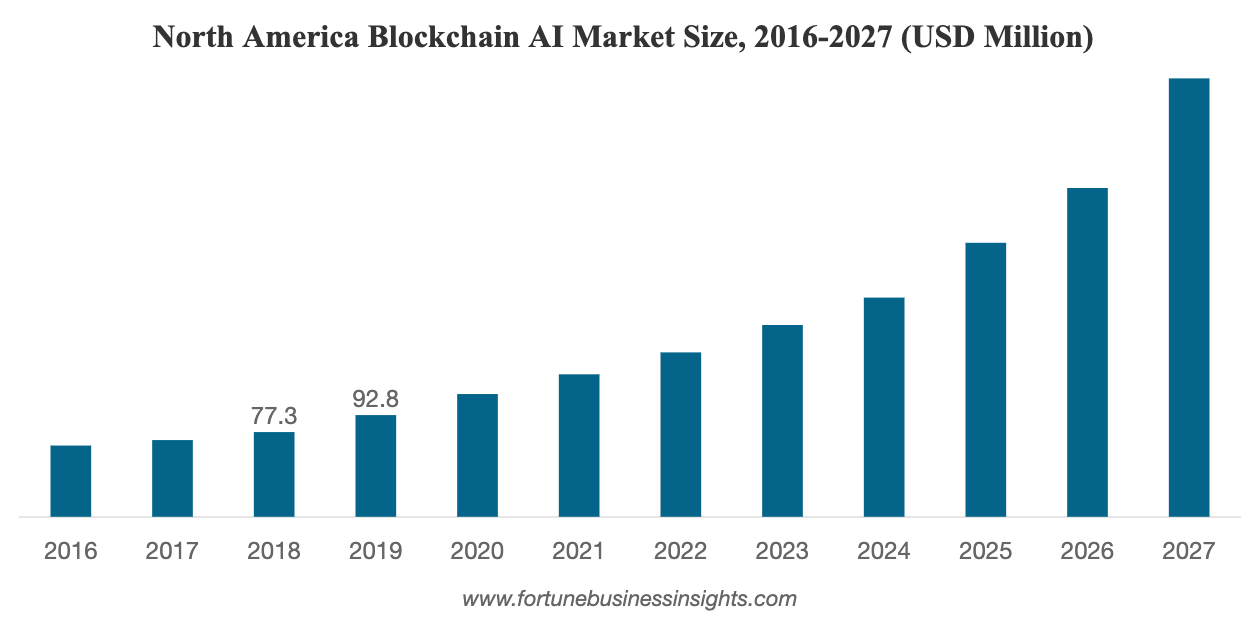
This surge shows that enterprises are no longer experimenting. They are adopting AI-blockchain solutions as a mainstream strategy to innovate and compete.
- Mainstream Adoption – More than 70% of enterprises use AI, and almost 90% deploy blockchain in some form.
- Market Growth – The combined AI-blockchain market reached USD 700 million in 2025, up from USD 228 million in 2020.
- Synergistic Benefits – AI drives automation and insights, while blockchain ensures trust, transparency, and data integrity.
- Cross-Industry Impact – Adoption is broad. Finance, supply chain, healthcare, and government already report on transformative pilot projects.
- Competitive Advantage – A leading bank achieved real-time loan approvals and 50% faster processing by integrating AI with blockchain.
How AI Enhances Blockchain Technology in Enterprises
AI is not just an addition to blockchain. It fundamentally enhances what blockchain can achieve in real-world enterprise settings. By tackling blockchain’s traditional challenges and adding intelligence to secure ledgers, AI makes enterprise blockchain solutions more scalable, secure, and insightful. Here are the key ways AI improves blockchain technology:
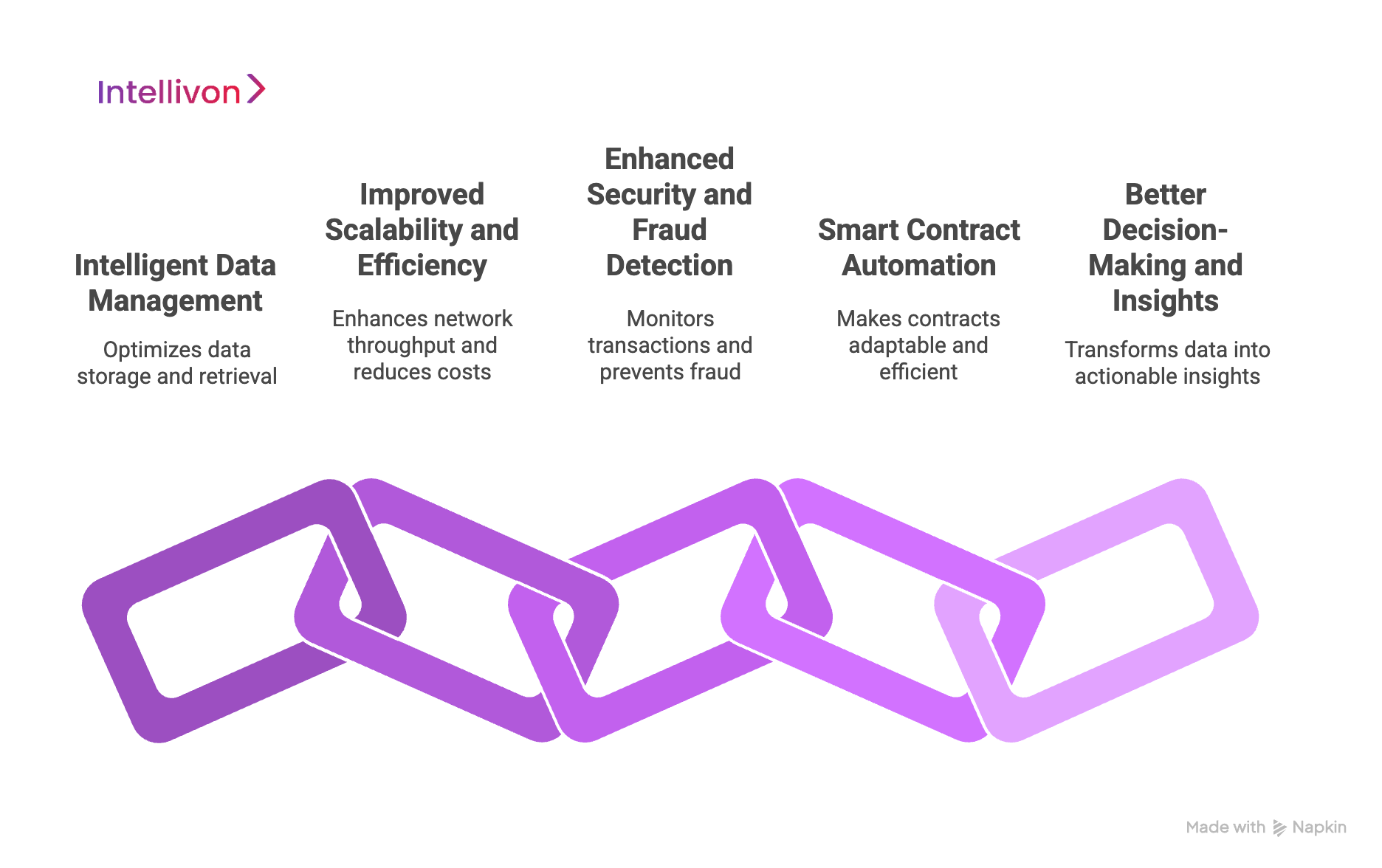
1. Intelligent Data Management
Blockchain often uses basic methods to handle data. AI introduces smarter management techniques, like machine learning (ML) algorithms that optimize how data is stored, routed, or indexed.
This reduces redundancy, speeds up retrieval, and turns blockchain from simple storage into an intelligent system that extracts value from ledger data.
2. Improved Scalability and Efficiency
Scalability remains a challenge for many blockchain networks. AI-driven optimizations can predict which node is most likely to validate a block, cutting down on wasted effort.
Techniques like decentralized ML or predictive compression ease network loads, increase throughput, and lower costs for enterprise workloads.
3. Enhanced Security and Fraud Detection
While blockchains are secure, applications and smart contracts can have vulnerabilities. AI strengthens this layer by monitoring transactions in real-time, detecting anomalies, and flagging fraud attempts before issues arise.
From identity validation to smart contract reviews, AI serves as a proactive safeguard, securing both the ledger and its applications.
4. Smart Contract Automation
Smart contracts execute agreements automatically, but AI makes them adaptable. AI can optimize execution, adjust terms based on market data, or use predictive analytics.
For instance, an AI-powered supply chain contract could dynamically change reorder levels, reducing errors and speeding up execution.
5. Better Decision-Making and Insights
Enterprises generate large amounts of blockchain data. AI transforms this raw data into useful information.
In supply chains, AI can predict demand increases by analyzing blockchain records. In healthcare, it can uncover treatment trends across tamper-proof data sets. Since blockchain ensures data integrity, the insights gained from it are both reliable and predictive.
Together, AI and blockchain show that the whole is greater than the sum of its parts. Enterprises that use both technologies unlock systems that are more efficient, secure, and intelligent than blockchain alone.
Top Use Cases of AI in Enterprise Blockchain in 2025
Enterprises in various industries are seeing the strong combination of AI and blockchain. In finance, energy, healthcare, and supply chains, these technologies are collaborating to improve security, streamline processes, and create new business models. Here are the leading real-world use cases where this combination is making a noticeable difference in 2025.
1. Fraud Detection and Security in Finance
AI and blockchain form a powerful duo in finance. Blockchain secures transaction records with an immutable ledger, while AI monitors patterns and behaviors to detect fraud in real time. Together, they provide proactive defense and trusted accountability.
Use Case 1: Real-Time Fraud Detection
Traditional systems often flag fraud after losses occur. With AI on blockchain, anomalies can be caught immediately. AI analyzes streams of transactional and behavioral data, while blockchain preserves an untampered record. If suspicious activity is found, the system can freeze accounts or trigger alerts instantly. This reduces financial losses and builds stronger customer trust.
Use Case 2: Anti-Money Laundering (AML) Compliance
AI models can spot subtle laundering patterns, like smurfing, layering, or complex fund flows, that human auditors often miss. Blockchain complements this by ensuring a full, auditable history of every transaction across networks. Together, they reduce false positives and make compliance more accurate. Financial institutions save costs and regulators gain stronger oversight.
Use Case 3: Identity and Access Security
AI-powered biometrics and behavioral analytics add another layer of protection to blockchain-backed identity systems. For example, if an AI detects unusual login behavior, it can demand multi-factor authentication. Blockchain ensures these checks are logged immutably, creating transparent audit trails. The result is a security framework that adapts to new threats while maintaining trust.
Real-World Example: Chainalysis
Chainalysis is a blockchain intelligence firm that applies ML to track illicit transactions across cryptocurrency networks. Its AI clusters addresses, identifies risk scores, and flags suspicious wallets in real time.
In 2023, Chainalysis integrated Alterya, an AI-powered fraud detection solution, to catch scammer wallets before they could harm users. By combining AI analysis with blockchain’s immutable records, Chainalysis helps financial institutions and regulators stop fraud faster and with higher accuracy.
2. Transparent Supply Chain Optimization
Modern supply chains are complex and prone to blind spots. Blockchain provides a shared, tamper-proof record of every step, while AI adds predictive intelligence. Together, they enable transparency, efficiency, and resilience across logistics networks.
Use Case 1: End-to-End Product Traceability
Blockchain records the entire journey of goods, from raw materials to retail shelves. AI algorithms analyze this on-chain data to verify authenticity, detect weak links, and spot quality issues early. This prevents fraud, ensures compliance, and boosts consumer confidence with trusted provenance records.
Use Case 2: Predictive Logistics and Demand Forecasting
AI models forecast demand spikes, shipment delays, or supplier bottlenecks using blockchain-secured historical data. With this foresight, managers can reroute shipments, optimize inventory, and negotiate better supplier terms. Blockchain guarantees that the insights rely on accurate, verified records, not manipulated data.
Use Case 3: Automated Smart Contracts in Supply Chains
Smart contracts on blockchain execute supplier agreements automatically. When paired with AI, these contracts become adaptive. For example, if AI predicts a delay, the smart contract could trigger a penalty clause or auto-order from a backup supplier. This reduces disputes and speeds up responses to disruptions.
Real-World Example: IBM Food Trust
IBM Food Trust uses Hyperledger blockchain to track food for Walmart, Nestlé, and Carrefour. By integrating AI (like IBM Watson), the system predicts recalls, monitors cold-chain conditions, and optimizes logistics. Walmart famously cut the time to trace contaminated lettuce from seven days to just 2.2 seconds using blockchain records. AI analytics now adds an extra layer, helping identify risks before they reach shelves. This synergy improves food safety, reduces waste, and saves millions in potential recall costs.
3. Secure Healthcare Data Management
Healthcare generates vast amounts of sensitive data that must remain private and accurate. Blockchain secures records against tampering, while AI analyzes them for better care and insights. Together, they create a trusted system for patient-centric healthcare.
Use Case 1: Patient-Centric Record Control
Blockchain allows patients to own and manage their medical records through digital identities. AI then links and verifies these records, matching biometric data, eliminating duplicates, and improving onboarding with new providers. Patients gain control, while providers get clean, reliable data.
Use Case 2: Diagnostic Support and Research Insights
AI models analyze blockchain-secured medical images, lab results, or wearable data to detect conditions early. Because blockchain guarantees authenticity, multiple specialists or researchers can trust the data. This leads to faster diagnoses and more collaborative research without compromising privacy.
Use Case 3: Privacy-Preserving Data Sharing
With federated learning and blockchain, hospitals can share insights without exposing raw patient data. AI trains on local records, while blockchain logs model updates and permissions. This allows global collaboration for drug development or pandemic response, all while maintaining strict patient confidentiality.
Real-World Example: Medifakt
Medifakt is an Estonia-based platform combining blockchain, IoT, and ML. Patients’ medical records and device data are stored immutably on-chain, while AI evaluates scans and health trends. For example, an AI diagnostic service can analyze an MRI uploaded to the blockchain, flagging potential issues for doctors. Specialists reviewing the same patient record can trust both the AI insights and the unaltered data. Medifakt not only secures health information but also incentivizes patients by rewarding them with tokens for sharing data that fuels valuable AI-driven research.
4. Decentralized AI Marketplaces
Decentralized AI marketplaces use blockchain to create open, trustless platforms where AI services, datasets, and models can be traded. AI provides the utility, while blockchain ensures transparency, payments, and governance without central control.
Use Case 1: AI Service Exchange
Developers can list AI services, such as translation, image recognition, or data analysis, on blockchain marketplaces. Smart contracts guarantee that when users pay, they receive results without relying on a middleman. This lowers costs and expands global access.
Use Case 2: Data Monetization and Sharing
Organizations and individuals can tokenize their datasets and sell access for AI training. Blockchain ensures the dataset isn’t misused, while AI models consume the data to improve accuracy. This creates a fair, privacy-preserving data economy.
Use Case 3: Autonomous AI Collaboration
AI agents can discover and transact with each other through blockchain protocols. For example, a logistics AI might hire a forecasting AI to predict delivery delays, paying in tokens automatically. This enables AI ecosystems to collaborate seamlessly.
Real-World Example: SingularityNET
SingularityNET (AGIX) is the most prominent decentralized AI marketplace. It allows developers to publish AI services while users pay with AGIX tokens. Smart contracts ensure fair transactions and record all activity immutably. The platform even enables AI agents to outsource tasks to each other, creating a growing network of interconnected services. By democratizing access and monetization, SingularityNET challenges the monopoly of big tech and fosters a truly open AI ecosystem.
5. Decentralized Compute Networks
AI models need enormous computing power, usually centralized in big data centers. Decentralized compute networks change this by pooling global resources on blockchain. AI gains cheaper, scalable processing, while blockchain ensures secure coordination and payments.
Use Case 1: Shared GPU Power for AI Training
Anyone with idle GPU resources can contribute to a blockchain marketplace. AI startups rent this power at a lower cost than major cloud providers. Blockchain manages payments and verifies that computations were done correctly.
Use Case 2: Distributed AI Inference at Scale
Instead of running AI tasks on a single server, workloads are split across multiple nodes. Blockchain ensures results are verified and nodes are rewarded fairly. This allows faster, cheaper inference for tasks like image recognition or natural language processing.
Use Case 3: Collective AI Model Building
Networks can incentivize participants to train and share parts of an AI model. Blockchain records contributions, while AI evaluates performance. Contributors earn tokens when their work improves the global model, enabling collaborative intelligence development.
Real-World Example: Akash Network
Akash Network is known as a “decentralized AWS.” It offers a blockchain-based marketplace for computing power, including GPUs for AI training. In 2023, an AI startup successfully trained a generative model using dozens of independent GPU nodes on Akash. The benefits were significantly lower costs and no reliance on a single cloud provider. Blockchain handled task allocation and payments, while AI achieved reliable training on a distributed infrastructure. This milestone proved that decentralized compute can power real-world AI workloads.
6. Smart Contract Optimization and Automation
Smart contracts are self-executing programs on blockchain. Adding AI makes them more secure, adaptive, and efficient. Together, they deliver smarter agreements that minimize errors, cut costs, and automate complex processes.
Use Case 1: Automated Vulnerability Detection
AI models trained on past hacks can scan smart contract code for risky patterns. Blockchain ensures the contract’s code and audit results remain tamper-proof, giving developers confidence before deployment.
Use Case 2: Adaptive Parameter Management
Many DeFi contracts rely on fixed rules for fees or collateral. AI can dynamically adjust these parameters by learning from market data. Blockchain executes the changes automatically, reducing governance delays.
Use Case 3: Intelligent Oracles for Real-World Data
AI-powered oracles feed blockchain contracts with reliable external data, like weather, credit scores, or image analysis. Smart contracts then act instantly, executing payouts or contract clauses with trusted, AI-enhanced inputs.
Real-World Example: CertiK
CertiK is a blockchain security firm that applies AI to smart contract audits. Its Skynet platform uses AI algorithms to continuously scan contracts for vulnerabilities and suspicious on-chain activity.
For example, in 2022, Skynet flagged irregular token minting in a DeFi protocol, alerting users before attackers could exploit it. By combining AI’s anomaly detection with blockchain’s transparency, CertiK delivers faster, more accurate security insights, helping protect billions in decentralized finance.
7. Digital Identity and Governance
Establishing a trusted digital identity is one of blockchain’s biggest promises. When paired with AI, identity systems become more secure, verifiable, and user-centric. Together, they also enable smarter governance for enterprises, DAOs, and even governments.
Use Case 1: Biometric Identity Verification
AI-powered facial recognition, iris scans, or behavioral biometrics confirm user identities with high accuracy. Blockchain then stores verified credentials immutably, ensuring that no one can forge or alter them. This reduces fraud and strengthens trust.
Use Case 2: Self-Sovereign Identity (SSI)
Blockchain lets users control their identity credentials directly. AI supports by verifying documents, detecting duplicates, and scoring trust levels. This enables seamless onboarding for services like banking, healthcare, or education, without central authorities holding all the data.
Use Case 3: Transparent Governance Systems
Blockchain records votes and decisions immutably, while AI analyzes participation patterns, detects anomalies, and provides insights. For DAOs or civic elections, this improves accountability and helps communities make more informed, fair decisions.
Real-World Example: WFP Building Blocks
The World Food Programme’s Building Blocks initiative combines blockchain with AI biometrics to distribute food aid. Refugees in Jordan authenticate themselves using AI-driven iris scans, and their entitlements are logged on a blockchain ledger. Over 400,000 people have securely accessed aid without physical IDs or bank accounts.
AI ensures accurate identity verification, while blockchain guarantees transparent, tamper-proof records. This system cut distribution costs, reduced fraud, and sped up delivery, proving how AI and blockchain together can transform humanitarian identity and governance systems.
8. Predictive Maintenance in IoT (Industry 4.0)
Industrial IoT (IIoT) systems generate massive amounts of sensor data. Blockchain secures these records, while AI analyzes them to predict equipment failures before they happen. Together, they reduce downtime, cut costs, and boost reliability.
Use Case 1: Trusted Sensor Data Logging
IoT sensors track equipment metrics like vibration, heat, or pressure. Blockchain stores this data immutably, ensuring it hasn’t been tampered with. AI then analyzes the data for early warning signals of breakdowns.
Use Case 2: Automated Maintenance Workflows
AI forecasts when a machine part will likely fail. Smart contracts on blockchain automatically schedule service, order replacements, or trigger warranty claims. This ensures timely fixes without human delays.
Use Case 3: Collaborative Maintenance Across Stakeholders
Manufacturers, operators, and insurers often need shared access to machine data. Blockchain provides a single source of truth, while AI generates predictive insights for all parties. This reduces disputes and fosters trust in service agreements.
Real-World Example: GE Aviation
GE Aviation uses blockchain and AI to manage jet engine maintenance. Their system processes over 2.5 million flight records daily. Blockchain ensures tamper-proof logs of engine performance, while AI models predict failures like turbine wear.
This combination has reduced inspection times by up to 50%, getting planes back in service faster and cutting operational costs. By merging blockchain’s integrity with AI’s predictive power, GE transformed how critical assets are maintained in aviation.
9. Energy Trading and Sustainability
The energy sector is shifting to renewables and decentralized grids. Blockchain provides secure transaction records, while AI optimizes production, consumption, and trading. Together, they create smarter, greener, and more transparent energy systems.
Use Case 1: Peer-to-Peer Energy Trading
Blockchain enables households with solar panels to sell excess power directly to neighbors. AI forecasts supply and demand, matching buyers with sellers in real time. This reduces waste and lowers costs.
Use Case 2: Renewable Energy Certification
Renewable Energy Certificates (RECs) or carbon credits can be tokenized on blockchain to prevent double-counting. AI verifies inputs, such as satellite data of solar farms or forests, ensuring certificates reflect real environmental impact.
Use Case 3: Smart Grid Optimization
AI predicts peak demand and directs devices like batteries or EVs to balance the grid. Blockchain ensures every action and payout is transparently recorded, rewarding participants who stabilize energy usage.
Real-World Example: PowerLedger
PowerLedger is an Australian company pioneering blockchain-based energy trading. Its platform has enabled over 1.67 GWh of trades across projects in Australia, Thailand, and Europe.
AI forecasts renewable supply and consumer demand, while blockchain smart contracts automate settlements. At Chiang Mai University in Thailand, PowerLedger helped 142 buildings achieve 30% renewable energy autonomy through AI-driven energy matching. This model proves how blockchain and AI together can build sustainable, decentralized energy ecosystems.
10. Insurance Automation and Parametric Contracts
Insurance has always been burdened by delays, paperwork, and disputes. Blockchain and AI together simplify and automate the process, making it faster, cheaper, and more accurate.
Use Case 1: Parametric Crop Insurance
Blockchain smart contracts release payouts automatically when weather thresholds (like rainfall levels) are met. AI analyzes satellite and sensor data for precision, ensuring farmers receive accurate, timely compensation.
Use Case 2: Flight Delay Insurance
AI predicts delays by analyzing weather and traffic data, while blockchain executes instant payouts when a threshold (e.g., 2-hour delay) is crossed. No claims or manual review needed.
Use Case 3: Disaster Relief & Climate Insurance
AI evaluates satellite images and sensor readings after disasters to assess damage intensity. Blockchain ensures tamper-proof data, triggering fast payouts to governments, businesses, and individuals in affected areas.
Real-World Example: Etherisc
Etherisc deployed blockchain-based crop insurance in Kenya with ACRE Africa. Farmers pay micro-premiums via mobile money, while AI analyzes rainfall and soil moisture data to assess drought or flood risks. When thresholds are breached, blockchain smart contracts automatically trigger payouts. Etherisc shows how blockchain and AI can make insurance faster, fairer, and more inclusive.
Real World Examples of Apps and Platforms Using AI in Blockchain
The convergence of AI and blockchain is no longer a pilot project. Global enterprises are running live platforms that combine these technologies at scale. Here are five proven examples in 2025.
1. Insurwave – for Marine and Specialty Insurance
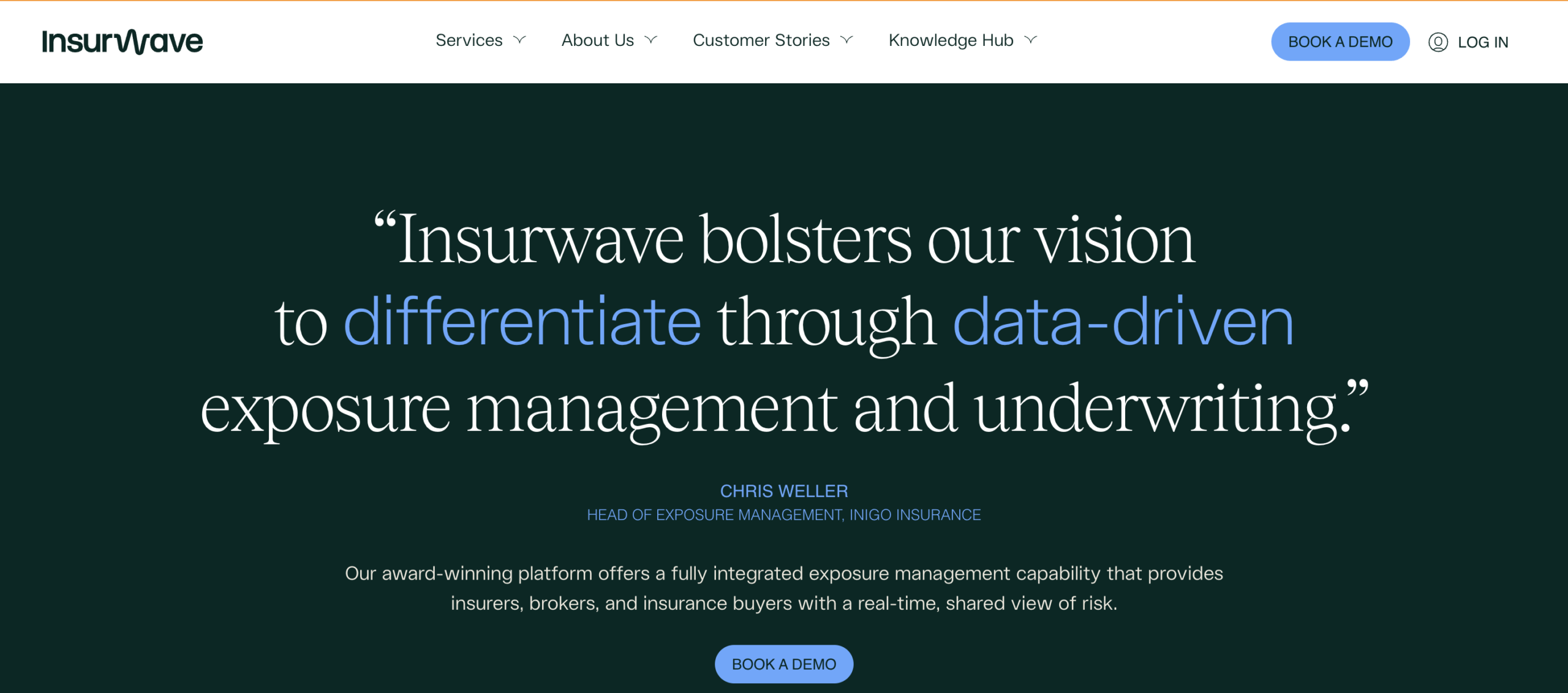
Insurwave is a global insurance platform used by major carriers and corporates. It leverages AI to analyze risk exposure and ingest large datasets, while blockchain ensures transparency across insurers, reinsurers, and clients.
The platform automates policy administration, premium settlement, and risk tracking. With AI insights, underwriters can make faster and more accurate decisions. Blockchain provides a single, auditable ledger that prevents disputes between multiple stakeholders.
The result is streamlined operations, stronger compliance, and reduced claims disputes for complex insurance programs.
2. OneConnect – AI-Powered Insurance Ecosystems with Blockchain
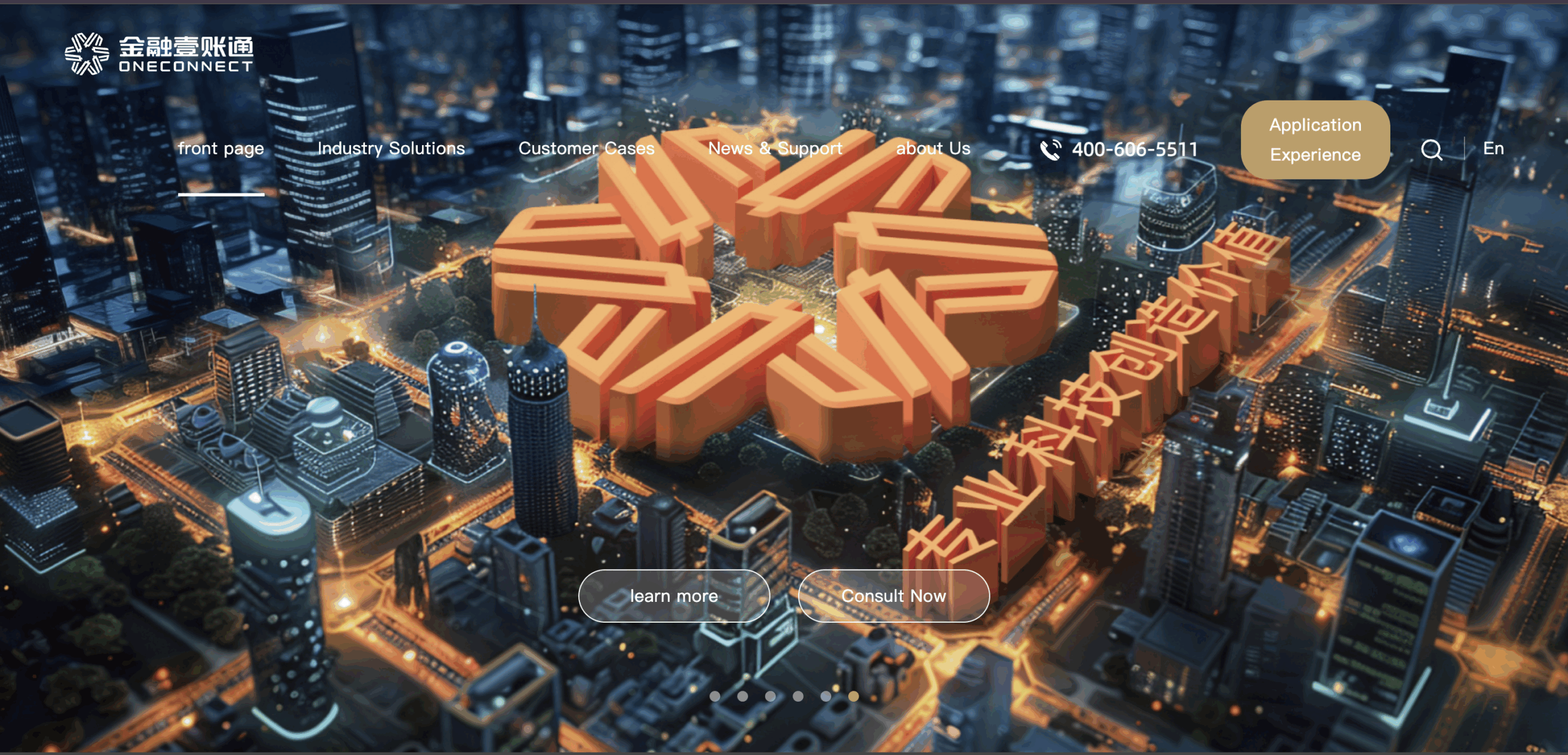
China’s Ping An Group has become a leader in digital insurance. Through its tech arm OneConnect, it has integrated AI for fraud detection, claims processing, and customer engagement. Blockchain underpins these systems by managing contracts and storing tamper-proof transaction records.
AI models evaluate risks in real time, while blockchain smart contracts handle policy updates and payouts. This creates faster, more efficient, and more reliable insurance ecosystems.
Because Ping An serves hundreds of carriers worldwide, its AI-blockchain systems are delivering measurable benefits across a massive enterprise network.
3. IBM Food Trust – AI Analytics on Blockchain Supply Chains
IBM Food Trust is deployed by retailers like Walmart and Nestlé to track food from farm to shelf. The blockchain ledger captures every step of the supply chain, ensuring data integrity and traceability.
On top of this data, IBM’s AI (Watson) analyzes patterns, forecasts demand, and detects anomalies. For example, the system can predict which batches of produce may spoil early or which supplier is likely to cause delays.
Blockchain ensures the data is trustworthy, while AI transforms it into actionable insights. The result: faster recalls, safer food, and more efficient supply chains at a global scale.
4. GE Aerospace – AI Inspections with Blockchain Maintenance Records
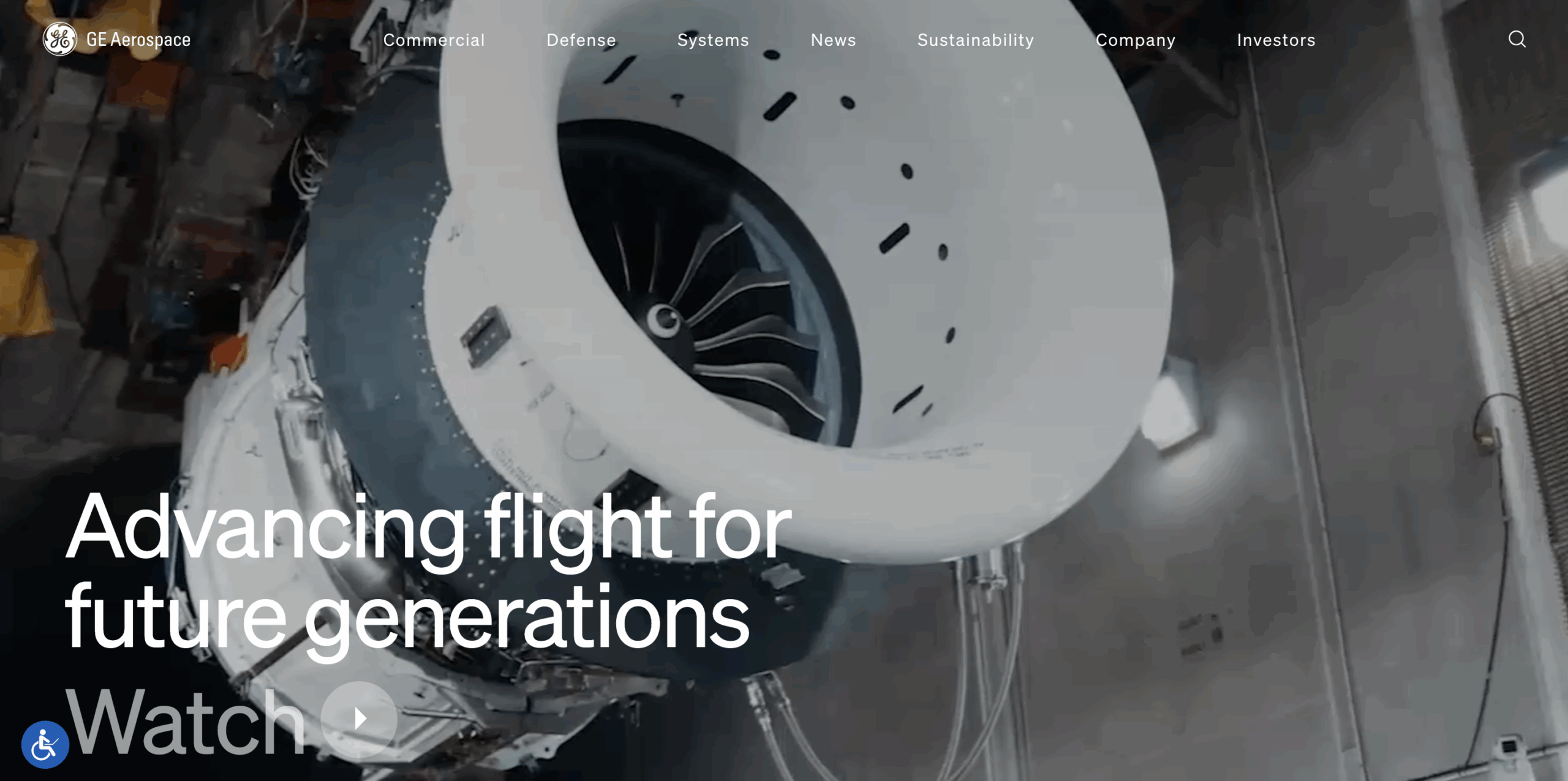
GE Aerospace combines AI-powered inspection systems with blockchain-based parts and maintenance records. AI tools analyze millions of flight records and component scans to predict failures early.
At the same time, blockchain records every part’s history, from manufacturing to maintenance, creating an immutable “back-to-birth” log. Regulators, airlines, and manufacturers can all trust the shared data.
This combination reduces inspection times by up to 50% and ensures safer, more reliable aircraft operations worldwide.
World Food Programme – Building Blocks for Humanitarian Aid
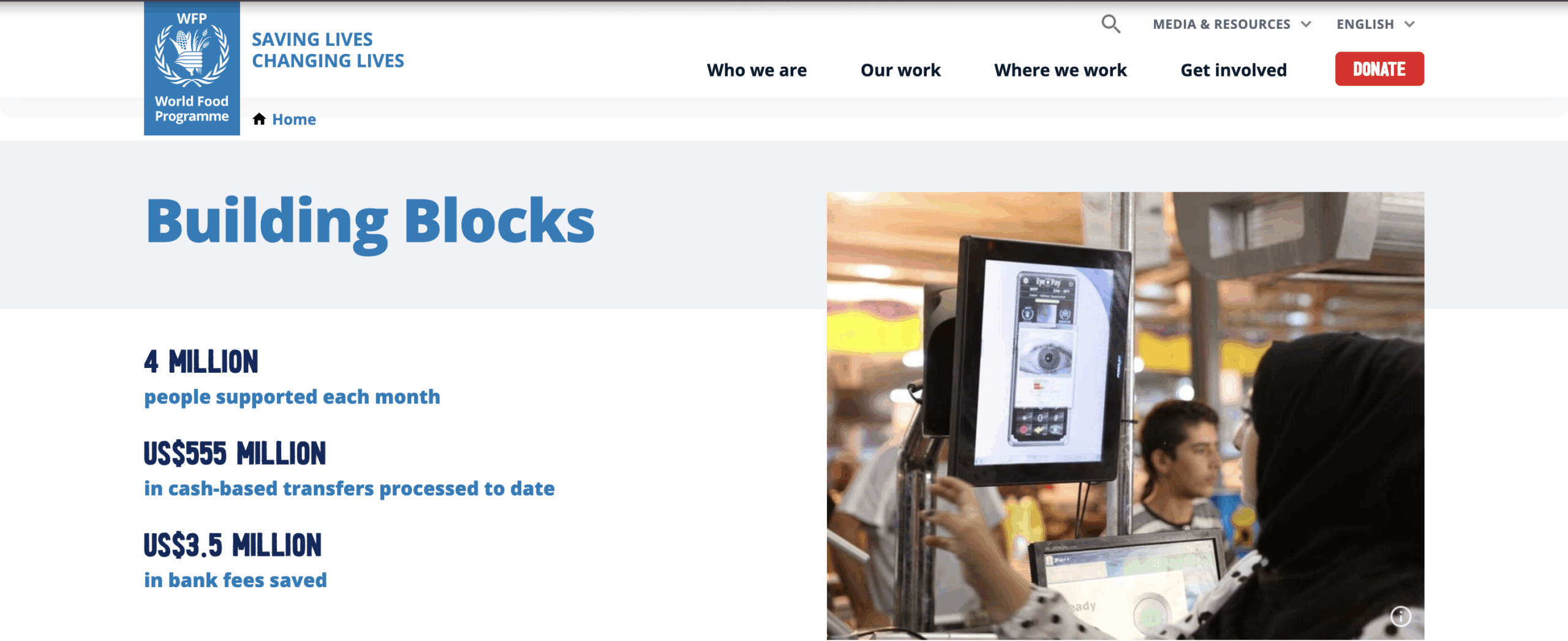
The UN’s World Food Programme uses blockchain to distribute food aid to refugees. Each beneficiary has a secure blockchain-based account linked to AI-powered biometric verification systems like iris scans.
When aid is delivered, AI confirms the individual’s identity, and blockchain logs the transaction. This prevents fraud, reduces costs, and speeds up delivery.
By 2025, the system will have served over a million people. It demonstrates how AI and blockchain together can solve global-scale challenges with transparency and efficiency.
These enterprise platforms prove that AI and blockchain are solving real problems. From insurance and aerospace to food safety and humanitarian aid, the results show measurable impact. As adoption spreads, enterprises that act now can capture a decisive advantage before these solutions become the industry norm.
Overcoming Common Challenges to AI Adoption in Enterprise Blockchain
Enterprises recognize the potential of AI in blockchain, but adopting these technologies in real life still has its challenges. At Intellivon, we understand these obstacles and create customized solutions that help organizations transition from pilot projects to full production with confidence.
1. Data Privacy and Security Concerns
Sensitive data in healthcare, finance, and government requires strict protection. Sharing such data on blockchain raises compliance issues.
Intellivon’s Solution:
We use privacy-preserving AI techniques like federated learning, homomorphic encryption, and zero-knowledge proofs. Together with blockchain’s permission controls, our systems allow you to run effective AI analytics while keeping sensitive data secure and compliant.
2. Integration with Legacy Systems
Older ERPs, CRMs, and banking platforms often hinder AI-blockchain integration.
Intellivon’s Solution:
Our team employs API-first designs and enterprise middleware connectors that smoothly connect blockchain with your existing systems. Whether it’s SAP, Oracle, or custom solutions, we ensure a seamless adoption without significant disruption.
3. High Computational Costs
Running AI on blockchain can demand a lot of resources and be expensive.
Intellivon’s Solution:
We create hybrid architectures that shift intensive AI processing off-chain while logging results and proofs on-chain. By using decentralized compute networks when needed, we cut costs and improve scalability.
4. Regulatory and Compliance Barriers
Changing regulations create uncertainty for financial services, insurance, and healthcare companies.
Intellivon’s Solution:
Our platforms come compliance-ready with built-in audit trails and explainable AI frameworks. We create systems that meet GDPR, HIPAA, and financial standards, ensuring innovation aligns with regulations.
5. Interoperability Across Blockchains
Many enterprises use different blockchain networks, but disconnected systems limit AI insights.
Intellivon’s Solution:
We develop cross-chain frameworks and oracle integrations that connect data across Ethereum, Hyperledger, Corda, and more. This allows unified AI-driven analytics while maintaining trust in decentralized records.
6. Trust and Explainability in AI
Opaque AI can weaken trust in enterprises, even when the blockchain ledger is clear.
Intellivon’s Solution:
We incorporate explainable AI (XAI) models that clarify decision-making. All insights are recorded on blockchain for complete traceability. This gives regulators, customers, and executives confidence in AI outcomes.
7. Scaling from Pilots to Production
Many organizations find it hard to scale AI-blockchain projects beyond proof of concept.
Intellivon’s Solution:
We focus on scaling enterprise deployments using modular AI services, Layer-2 blockchain scaling, and cloud-based infrastructures. By starting with one impactful use case and expanding gradually, we ensure sustainable growth.
With Intellivon as your partner, these challenges transform into opportunities. We create future-ready ecosystems where AI and blockchain collaborate to deliver real value to enterprises.
How We Develop AI-Powered Blockchain Solutions for Enterprises
At Intellivon, we use a clear seven-step framework to design and implement AI-powered blockchain solutions. This process helps us tailor each project to fit enterprise needs, integrate smoothly with existing systems, and achieve measurable results at scale.
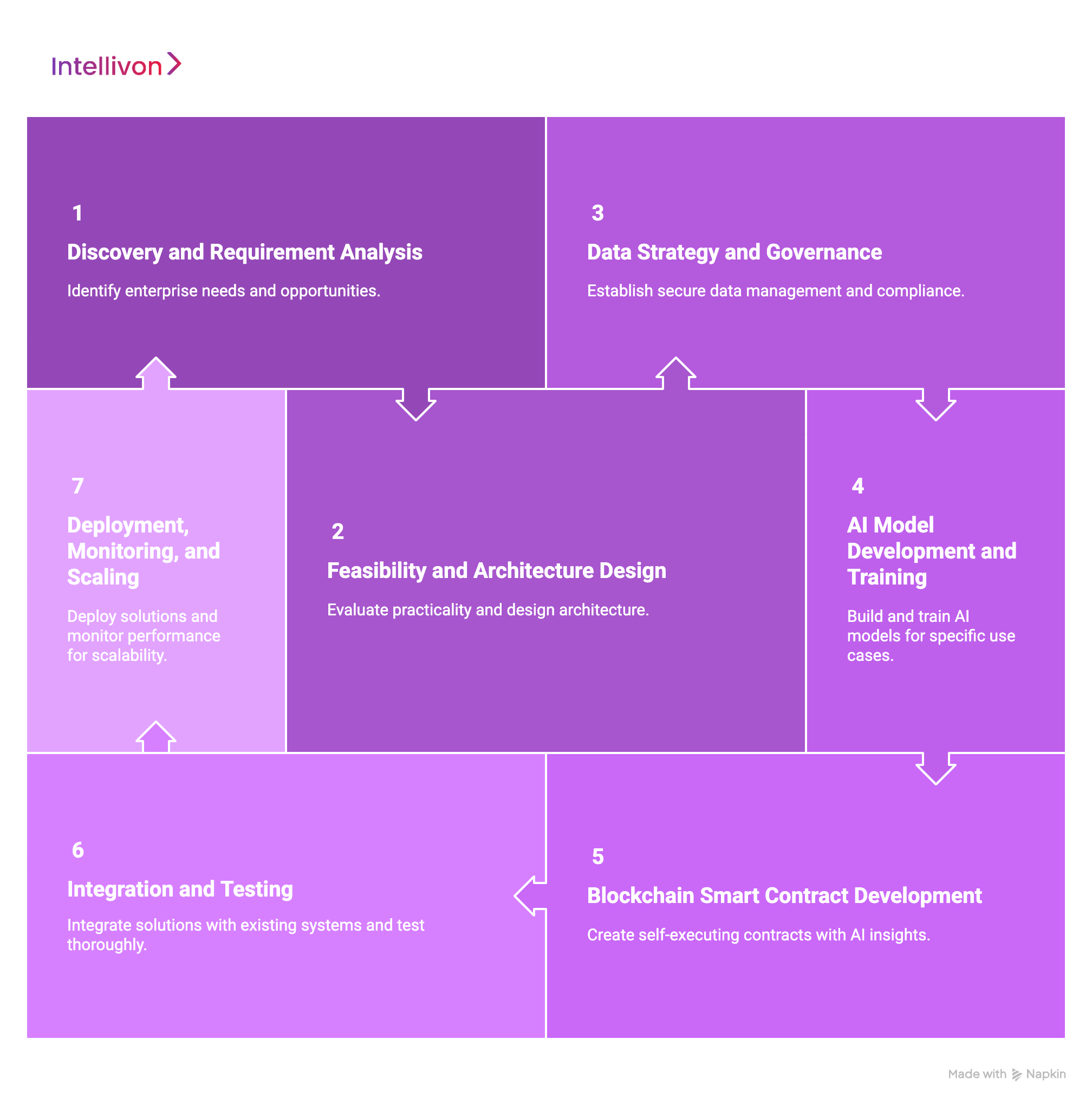
Step 1: Discovery and Requirement Analysis
Every enterprise has unique challenges. We start by meeting with stakeholders to outline objectives, pain points, and opportunities. This involves interviewing teams across business, technology, and compliance to find where AI and blockchain can make the most impact.
During this phase, we also conduct a thorough current-state assessment. We review existing workflows, data sources, and old platforms, spotting gaps that an AI-blockchain solution can fill. Our goal is to define clear use cases, whether that means reducing fraud in finance, improving supply chain traceability, or automating insurance claims. By the end of this phase, we will present a strategic roadmap that aligns with your long-term goals.
Step 2: Feasibility and Architecture Design
Not every idea is suitable for blockchain and AI integration; our second step is to test feasibility. We evaluate technical requirements, compliance needs, and cost factors to confirm that the project is practical and sustainable. This includes assessing blockchain platforms like Hyperledger, Ethereum, or Corda, as well as AI frameworks and cloud infrastructures.
Once we confirm feasibility, we design a high-level architecture. Our architects outline how data will flow, which components will be on-chain or off-chain, and how AI models will work with blockchain smart contracts. By combining scalability planning with compliance safeguards, we create a plan that balances innovation with reliability.
Step 3: Data Strategy and Governance
AI relies on high-quality data, and blockchain depends on trust. This step focuses on creating a secure data strategy. We identify data sources, like internal systems, IoT devices, or third-party providers, and establish processes to ensure accuracy and consistency.
At Intellivon, we also set up governance frameworks. This includes defining access rules, creating audit trails, and applying privacy-preserving AI methods like federated learning and encryption. By recording proofs of data lineage on the blockchain, enterprises can be confident that their AI models are learning from accurate, secure information.
This step also ensures compliance with regulations like GDPR, HIPAA, and industry-specific standards, allowing enterprises to innovate without regulatory obstacles.
Step 4: AI Model Development and Training
Once the data foundation is in place, we move on to building the intelligence. Our data scientists create and train ML models specific to the enterprise use case, such as fraud detection, predictive analytics, supply chain optimization, or dynamic pricing.
We focus on explainability and fairness from the outset. By using explainable AI methods, stakeholders can understand why a model made a particular decision, fostering trust throughout the enterprise. We also test models against large datasets and stress conditions to ensure they are reliable in high-volume, real-time environments typical in finance, healthcare, and logistics.
Step 5: Blockchain Smart Contract Development
Blockchain smart contracts are central to automation in our solutions. Our engineers design and deploy self-executing contracts that outline business rules, such as payments, compliance checks, or supply chain actions.
What makes Intellivon special is how we integrate AI into these contracts. Instead of static logic, our smart contracts can reference AI insights, including anomaly scores, risk assessments, or predictive forecasts. For example, a smart contract in insurance can adjust premiums in real time if AI detects a lower risk, or in logistics, it can reroute shipments based on AI forecasts of delays. This adaptability ensures the system is both secure and continuously improving.
Step 6: Integration and Testing
Enterprises already handle essential operations on ERP, CRM, and industry-specific platforms. To encourage adoption, our solutions integrate seamlessly with these legacy systems. We use APIs, middleware, and custom connectors to bridge blockchain and AI capabilities with existing workflows, reducing disruptions.
After integration, we conduct thorough testing. We perform security audits, performance checks, and interoperability tests across various blockchain networks. Our quality assurance process also includes scenario testing with AI models to confirm that predictions and smart contract triggers align properly.
The result is a reliable solution that enterprises can trust to function in production without downtime or risk.
Step 7: Deployment, Monitoring, and Scaling
The last step is deployment, but our work continues. We manage the rollout in controlled stages, starting with a limited scope before scaling up across the enterprise. This approach allows organizations to see immediate benefits while minimizing risk.
After deployment, we set up monitoring dashboards to track both blockchain activity and AI performance. These dashboards provide real-time insights into system health, transaction flows, and model accuracy. Importantly, we design all solutions with scalability in mind.
Modular architectures, Layer-2 scaling, and hybrid cloud setups make it easy to expand to new use cases and locations. With ongoing support from Intellivon, enterprises can continually adjust their AI-blockchain systems as business and regulatory needs change.
By following this seven-step process, Intellivon helps enterprises not just adopt AI in blockchain but also transform their operations with solutions that are secure, scalable, and ready for the future.
Future Trends of AI in Blockchain for Enterprises
AI in blockchain is still evolving, but companies are already looking ahead. The next wave of innovation will change industries, create new business models, and raise standards for security, efficiency, and intelligence. Here are the most important trends to watch:
1. Autonomous AI Agents on Blockchain
AI agents are moving from experiments to real-world use. These agents can negotiate contracts, trade assets, and manage resources without human input, completing actions directly on the blockchain.
For instance, in supply chains, AI bots will automatically find suppliers, negotiate prices, and finalize orders through smart contracts. Blockchain ensures transparency while AI provides decision-making support. This mix creates decentralized business networks where machines act as economic participants.
2. Mainstream Decentralized AI Marketplaces
Today, platforms like SingularityNET and Fetch.ai demonstrate how AI services can be bought and sold on blockchain. In the future, companies will adopt these marketplaces widely.
This shift means companies will no longer rely only on large cloud providers for AI models. Instead, they can access a global catalog of decentralized AI services, pay with tokens, and verify transactions on blockchain. This change lowers costs, expands options, and reduces monopolies in the AI field.
3. Standardized AI-Powered Smart Contracts
Smart contracts are changing from inflexible rules to data-driven systems. With AI integration, contracts can alter terms, predict risks, and automate responses in real time.
For example, an insurance contract could use AI to evaluate satellite images after a storm and trigger immediate payouts. In finance, lending contracts might adjust interest rates based on AI-driven risk scores. This trend will make smart contracts more adaptable, reducing the need for human intervention and improving accuracy.
4. Blockchain as a Trusted AI Data Layer
AI relies on the data it processes. Blockchain offers the secure foundation that businesses need for reliable AI.
In the future, AI models will increasingly train and run on blockchain-secured datasets, ensuring that inputs are genuine and can be audited. This trend is especially important in regulated fields like healthcare and finance, where data integrity directly affects results.
5. Convergence with IoT and Edge Computing
AI and blockchain are both moving beyond the cloud. Companies are starting to combine these technologies with IoT and edge devices.
Imagine a factory where IoT sensors send machine data to a blockchain. AI at the edge analyzes this data in real time to predict failures. Smart contracts then trigger maintenance orders instantly, all without central control. This trend will transform manufacturing, logistics, and energy systems into self-managing ecosystems.
6. Sustainability and Green AI-Blockchain Solutions
Businesses are under pressure to lower their carbon footprints. AI and blockchain will work together to create greener solutions.
AI can optimize energy use in data centers and blockchain networks, while blockchain can track and verify renewable energy consumption. Together, they will enable transparent carbon accounting and support more sustainable business operations.
7. Regulation-Ready AI-Blockchain Frameworks
As adoption increases, regulators will demand accountability. Companies will need AI and blockchain systems that are easy to understand, transparent, and compliant from the start.
Future platforms will likely come with built-in compliance features, such as AI explainability dashboards connected to blockchain audit trails. This will help companies innovate confidently while meeting regulatory demands in sectors like banking, insurance, and healthcare.
The future of AI in blockchain is about autonomy, trust, scalability, and compliance. Companies that adopt these trends early will not only keep pace with competitors but also set the benchmark for their industries.
Conclusion
These trends show that AI and blockchain are not just coming together. They are shaping the technology landscape for businesses in the next decade. By getting ready now, organizations can protect their operations, open new revenue streams, and stay ahead of changes in the industry. The next step is to pick the right partner to help with this transformation.
Why Choose Intellivon’s AI-Powered Blockchain Solutions
With 15+ years of expertise in enterprise AI and blockchain, Intellivon is your trusted partner for building secure, scalable, and future-ready solutions. From fraud prevention to supply chain transparency, we help enterprises turn complexity into competitive advantage.
Why Choose Intellivon for Your AI-Blockchain Solution?
- Tailored AI-Blockchain Frameworks for Your Industry: We design intelligent blockchain systems customized to your sector, compliance needs, and operational workflows.
- Seamless Integration with Enterprise Platforms: Our solutions connect effortlessly with ERP, CRM, IoT, and legacy systems, ensuring smooth enterprise-wide adoption.
- Proven ROI and Enterprise Scalability: Built for long-term value, our deployments reduce costs, accelerate decision-making, and scale with your business growth.
Want to accelerate digital transformation with trusted AI-blockchain solutions? Let’s build the right strategy for your enterprise.
Book a discovery call with Intellivon today and get:
- A full audit of your enterprise blockchain readiness.
- A tailored roadmap aligned with your business objectives.
- A detailed implementation plan with projected ROI.
FAQ’s
Q1. What is the role of AI in blockchain?
A1. AI enhances blockchain by adding intelligence to data stored on secure ledgers. It improves decision-making, automates smart contracts, detects fraud, and scales transaction efficiency, making enterprise blockchain solutions far more powerful and adaptive.
Q2. How can enterprises benefit from AI-powered blockchain?
A2. Enterprises gain secure, automated, and data-driven operations. AI provides insights and predictions, while blockchain ensures trust and transparency. Together, they reduce costs, improve compliance, boost efficiency, and create new revenue streams across industries like finance, healthcare, and logistics.
Q3. What industries are using AI in blockchain today?
A3. Industries leading adoption include finance, insurance, supply chain, healthcare, energy, and manufacturing. Enterprises use AI and blockchain together for fraud detection, predictive analytics, parametric insurance, traceability, sustainability tracking, and autonomous smart contract execution.
Q4. What challenges limit AI adoption in blockchain?
A4. Key challenges include data privacy, regulatory compliance, interoperability, and high compute costs. Enterprises also face skill shortages and integration issues with legacy systems. However, providers like Intellivon address these barriers with secure, scalable, compliance-ready solutions.
Q5. What future trends will shape AI in blockchain?
A5. Future trends include autonomous AI agents, decentralized AI marketplaces, AI-powered smart contracts, and convergence with IoT and edge computing. Enterprises adopting these trends early will gain stronger efficiency, compliance readiness, and competitive advantage in the digital era.

